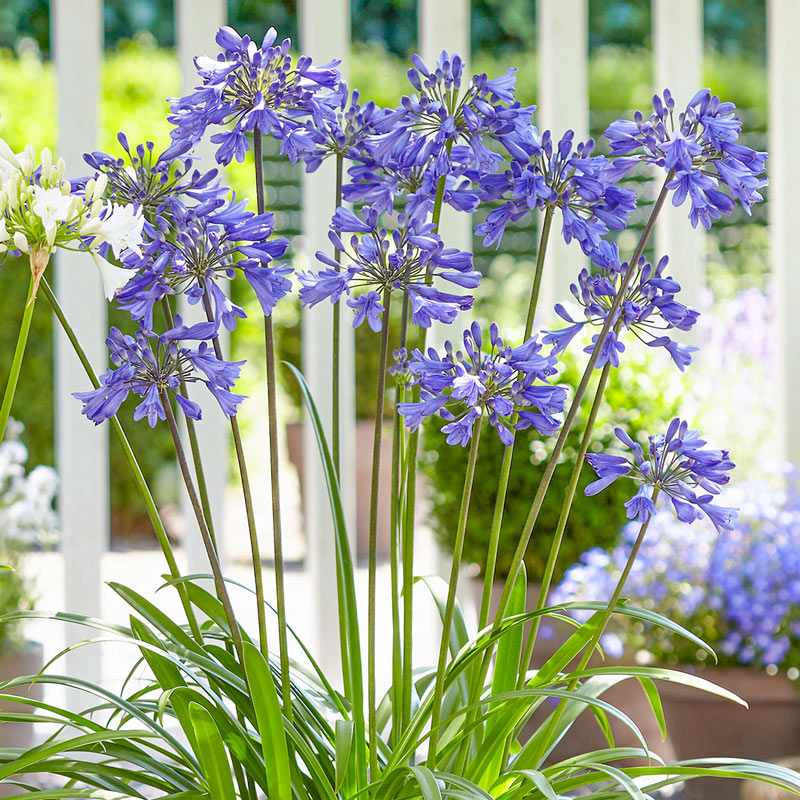Understanding the Art of Agapanthus Treatment: Necessary Actions for Healthy Development and Dynamic Flowers
In the realm of horticulture, the farming of agapanthus stands as a satisfying undertaking for those that seek to nurture these classy flowering plants. From choosing the best selection to understanding trimming techniques, the journey towards growing growing agapanthus plants is diverse and holds the vital to unlocking the full potential of these herb gems.
Selecting the Right Agapanthus Selection

When choosing the best Agapanthus selection for your yard, think about elements such as environment suitability, bloom color, and development routine. Agapanthus, typically known as Lily of the Nile or African lily, is available in a selection of shades ranging from tones of blue and purple to white. Pick a flower shade that enhances your existing yard palette to create a harmonious landscape. Additionally, think about the environment in your region to ensure the Agapanthus selection you pick can prosper in your details problems. Some selections are a lot more forgiving of chilly temperatures, while others like warmer environments. Understanding the growth routine of various Agapanthus ranges is vital for proper placement within your yard. Some selections have a clumping development routine, suitable for boundaries or containers, while others have an even more dispersing nature, ideal for ground cover or mass plantings. By thoroughly evaluating these aspects, you can select the ideal Agapanthus variety to improve the appeal of your yard.
Perfect Planting Problems
Thinking about the optimal environmental demands is necessary for successful Agapanthus farming. Agapanthus flourishes in well-draining dirt with a somewhat acidic to neutral pH level. When planting, choose a location that obtains full sunlight to partial color. In hotter environments, offering some mid-day color can protect against scorching of the fallen leaves. Agapanthus plants are sensitive to chilly temperature levels and must be safeguarded from frost throughout cold weather.
To make sure healthy and balanced growth and lively blooms, plant Agapanthus light bulbs at a depth of concerning 2-4 inches and area them 8-12 inches apart. Adding natural matter, such as compost, to the soil can improve drain and fertility, promoting robust origin development. Mulching around the base of the plants aids preserve dampness and subdues weed development. Regular watering is important, especially during the expanding season, to keep the soil consistently wet yet not waterlogged.
Watering and Fertilizing Tips
Keeping proper wetness degrees and providing necessary nutrients are key elements in the treatment routine for Agapanthus plants. When it comes to watering Agapanthus, it is important to strike a balance. These plants like consistently moist soil but are vulnerable to root rot if overwatered.
Fertilizing Agapanthus is vital for advertising healthy development and respected flowers. Apply a well balanced fertilizer, such as a 10-10-10 formula, in the very early springtime as new development emerges. Repeat this application every 6-8 weeks throughout the expanding period. Stay clear of extreme fertilization, as it can bring about rich vegetation at the expense of flowers. Constantly follow the supplier's guidelines for proper dilution and application techniques. By complying with these watering and feeding pointers, you can guarantee your Agapanthus plants thrive and create lively, resilient blossoms.
Pruning Techniques for Agapanthus
Pruning Agapanthus plants at the suitable times and with appropriate strategies is vital for preserving their wellness and promoting optimal development and flowering. The perfect time to prune Agapanthus is in late winter or early spring before brand-new development emerges.
Deadheading invested flowers can likewise redirect the plant's power right into generating even more blossoms instead than establishing seeds. If you want to accumulate seeds for propagation, leave some blossoms to completely dry and fully grown visit here on the plant.
Remember to use tidy, sharp tools to make precise cuts and minimize the threat of introducing conditions. Agapanthus. Routine pruning will help keep your Agapanthus looking neat and healthy while making certain a bountiful screen of lovely blossoms
Taking Care Of Typical Pests and Illness
After making certain correct pruning methods for Agapanthus, it is necessary to deal with typical bugs and conditions that can impact the health and vitality of these plants. Agapanthus plants are usually sturdy yet can still drop victim to certain problems. One typical bug that affects Agapanthus is the Agapanthus gall midget. This small, orange fly lays its eggs in the foliage, leading to altered development and blossom Read Full Article buds that fail to open up. To battle this pest, trim and damage any kind of affected plant parts and think about utilizing insecticidal soap.
An additional typical concern is fungal leaf place, which provides as dark sores on the fallen leaves. To avoid fungal diseases, guarantee excellent air circulation around the plants, prevent overhanging watering, and get rid of any kind of infected leaves quickly. Furthermore, Agapanthus plants can experience root rot if they are planted in inadequately draining soil. To avoid this, plant Agapanthus in well-draining soil and avoid overwatering. By being cautious and taking prompt action against bugs and illness, you can view aid your Agapanthus plants grow and produce lively blossoms.

Final Thought
Finally, mastering the art of agapanthus treatment includes picking the ideal range, providing suitable growing conditions, correct watering and fertilizing, proper pruning strategies, and dealing with usual pests and conditions. By following these crucial steps, you can make sure healthy development and lively blooms for your agapanthus plants. Bear in mind to consistently check and maintain your plants to advertise their general health and long life.
To make sure healthy and balanced development and vibrant blooms, plant Agapanthus light bulbs at a depth of concerning 2-4 inches and room them 8-12 inches apart. By complying with these watering and feeding suggestions, you can ensure your Agapanthus plants grow and produce lively, long-lasting blossoms.
One typical parasite that affects Agapanthus is the Agapanthus gall midge. Additionally, Agapanthus plants can suffer from origin rot if they are planted in poorly draining pipes dirt. By adhering to these vital steps, you can ensure healthy growth and dynamic blooms for your agapanthus plants.